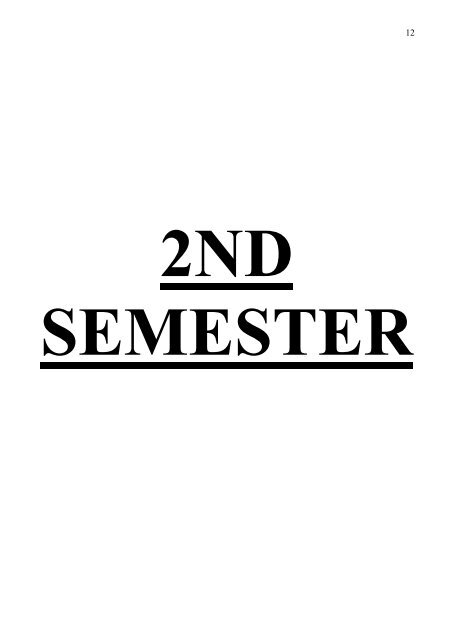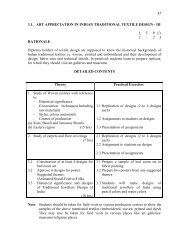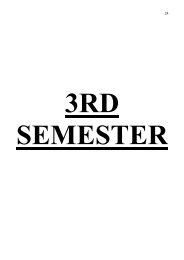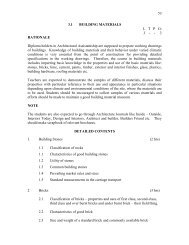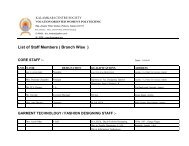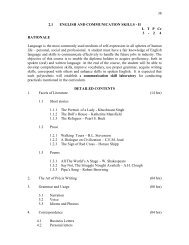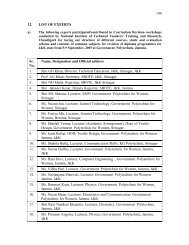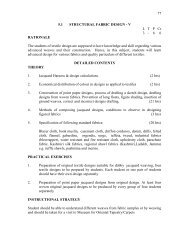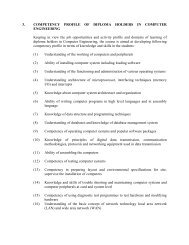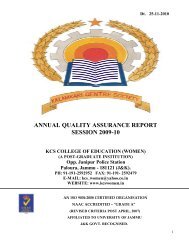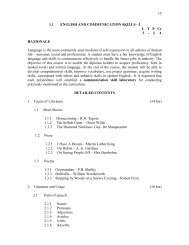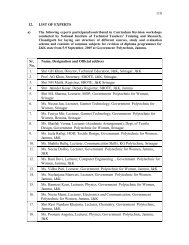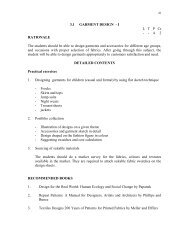download Syllabus for 2nd Semester
download Syllabus for 2nd Semester
download Syllabus for 2nd Semester
Create successful ePaper yourself
Turn your PDF publications into a flip-book with our unique Google optimized e-Paper software.
12<br />
2ND<br />
SEMESTER
13<br />
2.1 – ENGLISH AND COMMUNICATION SKILLS – II<br />
RATIONALE<br />
L T P<br />
3 - 2<br />
Language is the most commonly used medium of self-expression in all spheres of human lifepersonal,<br />
social and professional. A student must have a fair knowledge of English language and skills<br />
to communicate effectively to handle the future jobs in industry. The objective of this course is to<br />
enable the diploma holders to acquire proficiency, both in spoken (oral) and written language. At the<br />
end of the course, the student will be able to develop comprehension skills, improve vocabulary, use<br />
proper grammatical, acquire writing skills, correspond with others and enhance skills in spoken<br />
English. It is expected that each polytechnic will establish a Communication Skill Laboratory <strong>for</strong><br />
conducting practicals mentioned in the curriculum.<br />
1. Facets of Literature<br />
Short Stories<br />
The Portrait of a Lady – Khushwant Singh<br />
The Doll’s House – Katherine Mansfield<br />
The Refugees – Pearl S. Buck<br />
Prose<br />
Walking Tours – R.L. Stevenson<br />
A Dialogue on Civilization – C.E.M. Joad<br />
The Sign of Red Cross – Horace Shipp<br />
Poems<br />
All the World’s A Stage – W.Shakespeare<br />
DETAILED CONTENTS<br />
Say Not, The Struggle Nought Availeth – A.H.Clough<br />
Pipa’s Song – Robert Browning<br />
2. The Art of Précis Writing<br />
3. Grammar<br />
Narration<br />
Voice<br />
Idioms and Phrases<br />
4. Correspondence<br />
Business Letters<br />
Personal Letters
14<br />
5. Drafting<br />
Report Writing<br />
Inspection Notes<br />
Memos, Circulars and Notes<br />
Telegrams<br />
Press Release<br />
Agenda and Minutes of Meetings<br />
Applying <strong>for</strong> a Job<br />
6. Glossary of Technical & Scientific Terms<br />
7. Communication<br />
Media and Modes of Communication<br />
Channels of Communication<br />
Barriers to Communication<br />
Listening Skills<br />
Body Language<br />
Humour in Communication<br />
LIST OF PRACTICALS<br />
1. Browsing In<strong>for</strong>mation on Internet<br />
2. Group Discussions<br />
3. Mock Interviews<br />
4. Telephone Etiquette<br />
5. Situational Conversation<br />
Note: The Text Book on “English and Communication Skills, Book-II “ By Kuldip Jaidka at. el.<br />
prescribed by NITTTR, Chandigarh should be used <strong>for</strong> teaching and setting-up question papers.<br />
RECOMMENDED BOOKS<br />
1. English and Communication Skills, Book-II By Kuldip Jaidka, Alwainder Dhillon and<br />
Parmod Kumar Singla prescribed by NITTTR, Chandigarh & published by Abhishek<br />
Publication, 57-59, Sector-17, Chandigarh.<br />
2. Essentials of Business Communication by Pal and Romalling, Sultan Chand and Sons.<br />
3. The Essence of Effective Communication, Pundow and Panthon; Prentice Hall of India.
15<br />
4. New Design English Grammar, Reading and Writing Skills by AL Kohli (Course A and<br />
Course B), Kohli Publishers, 34, Industrial Area, Phase-II, Chandigarh.<br />
5. New Design English Reading and Advanced Writing Skills <strong>for</strong> Class XI and XII by MK<br />
Kohli and AL Kohli Publishers, 34, Industrial Area, Phase-II, Chandigarh.<br />
6. A Practical English Grammar by Thompson and Marlinet.<br />
7. Spoken English by V Sasikumar and PV Dhamija; Tata McGraw Hill.<br />
8. English Conversation Practice by Grount Taylor; Tata McGraw Hill.<br />
9. Developing Communication Skills by Krishna Mohan and Meera Banerji; MacMillan India<br />
Ltd. Delhi.<br />
10. Business Correspondence and Report Writing by RC Sharma and Krishna Mohan; Tata<br />
McGraw Hill Publishing Company Ltd. New Delhi.<br />
11. Communication Skills by Ms.R Datta Roy and KK Dhir; Vishal Publication, Jalandhar.
16<br />
RATIONALE<br />
2.2 – INTRODUCTION TO TEXTILE PROCESSES – II<br />
L T P<br />
3 - 2<br />
The students of textile design are supposed to have introductory knowledge and skill related to various<br />
fibres, yarns anmd fabrics. Thus in this subject students learn different fibres, yarns and fabrics and<br />
their manufacturing techniques.<br />
Theory<br />
1. Introduction to mixing and blending<br />
techniques.<br />
2. Principles of blow room, carding,<br />
drawing/gilling, speed frame, ring frame<br />
and doubling.<br />
3. Process flow of cotton, woolen and<br />
worsted system of yarn manufacture.<br />
DETAILED CONTENTS<br />
Practical Exercises<br />
2.1 Understanding different spinning processes by<br />
textile mill visit.<br />
Estimation of fibre diameter and yarn<br />
diameter by projection microscope.<br />
Understanding different processes by textile<br />
mill visit.<br />
Inspection of yarns <strong>for</strong> S and Z twist, hard<br />
twisted and soft twisted yarns.<br />
Identification of different types of yarns<br />
studied in theory.<br />
4. Insertion of twist, S and Z twist, type of<br />
package in spinning and doubling.<br />
5. Knowledge of standard yarns, bulked<br />
yarn, core yarn, high tenacity yarn, luster<br />
yarn, tyre cord yarn, carpet yarn, stretch<br />
yarn, twist-de-twist yarn, spiral yarn,<br />
grandrel yarn, hosiery yarn.<br />
6. Introduction to yarn packages.<br />
7. Process flow of fabric manufacturing. 7.1 Understanding different processes of weaving<br />
through textile mill visit.<br />
8. Basic principles of weft and wrap knitting Understanding process of knitting through<br />
and use of knitted fabrics.<br />
textile mill visit.<br />
9. Process flow of wet processing. Understanding of dyeing an printing through<br />
textile mill visit.<br />
Note: The student may be exposed to different types of textile manufacturing processes through textile<br />
mill visit so that they are able to understand the subject properly.<br />
RECOMMENDED BOOKS<br />
1. Textile Fibre by Ghol and Valansik.<br />
2. Yarn to Fabric by Peter Schwarz.<br />
3. Fibre to Fabric by BP Corbman.<br />
4. Textile Fibres and their processings by KP Hess.<br />
5. Elemenmtary Textile by Parul Bhatnagar, Abhishek Publisher, Chandigarh.
17<br />
RATIONALE<br />
2.3 – GARMENT DESIGNING – II<br />
L T P<br />
2 - 4<br />
The knowledge and skill related to principles of garment design is essential <strong>for</strong> the students of diploma<br />
programme of garment technology in order to develop the understanding regarding how to make a<br />
garment design using scale, space, proportion, rhythm, harmony, textures and collage from waste<br />
material.<br />
DETAILED CONTENTS<br />
Theory<br />
Practical Exercises<br />
1. Optical illusion created by lines. 1.1 Create an impression of optical illusion using<br />
geometrical shapes and lines (10 sheets).<br />
1.2 To collect and study the various cuttings from<br />
the magazines, newspapers etc. regarding the<br />
optical illusion created by the use of lines,<br />
shapes, curves and colour and to study<br />
harmony and balance of design.<br />
2. Opaque and transparent colour-define 2.1 Make a sheet <strong>for</strong> opaque and transparent<br />
colours.<br />
3. Colour Schemes<br />
3.1 Prepare sheets <strong>for</strong> these colour schemes.<br />
- Achromatic<br />
3.2 Make a sheet showing colour in relation to<br />
- Monochromatic<br />
figure proportion.<br />
- Analogues<br />
3.3 Compose different figures using colours to<br />
- Complementary or contrasting<br />
create optical illusion.<br />
- Split complementary<br />
4. Computerized colour 4.1 Colour Key Scheme.<br />
4.2 How does the Colour Key System related to<br />
your personal colouring.<br />
4.3 Colour Key combinations <strong>for</strong> both men and<br />
women.<br />
4.4 Special colour key considerations <strong>for</strong> both<br />
men and women.<br />
5. Summary of Colour Key System. 5.1 Skin Colouring.<br />
5.2 Hair Colouring.<br />
5.3 Eye Colouring.<br />
Note: The teacher should encourage the students to do market surveys, field visits and the students<br />
may be exposed to fairs and exhibitions.
18<br />
RATIONALE<br />
2.4 – DRAFTING AND PATTERN MAKING – II<br />
L T P<br />
2 - 4<br />
The students should know various considerations in making of garments, scope and importance of<br />
drafting and pattern making so that they are able to take measurements, interpret the style of any given<br />
design and make the pattern. The subject, there<strong>for</strong>e, deals with basics of pattern making and styling of<br />
garments.<br />
Theory<br />
1. Preparation of basic Block - I<br />
- Gents Shirt<br />
- Ladies Blouse<br />
- Night Wear<br />
DETAILED CONTENTS<br />
Practical Exercises<br />
1.1 Practice on drafting and estimation <strong>for</strong> gents<br />
garments.<br />
1.2 Practice eon drafting and estimation <strong>for</strong> ladies<br />
garments.<br />
1.3 Practice on drafting of various types of casual<br />
wear (Apron, Night Wear and other work<br />
clothes).<br />
2.1 Make a sheet of basic 8-head figure.<br />
2. Study of human anatomy in relation to fashion<br />
proportions.<br />
3. Fashion figures and illustrations. 3.1 Make 10 sheets of fashion figures.<br />
4. Fashion faces and illustrations. 4.1 Make 5 sheets of Fashion faces with different<br />
expressions.<br />
5. Fashion Accessories and Illustrations. 5.1 Make Fashion figures with accessories<br />
(Minimum 4 sheets).<br />
6. 6.1 Make fashion posters <strong>for</strong> and expert house on<br />
½ imperial sheet.<br />
7. 7.1 Prepare 1.4 imperial file considering<br />
minimum 15 design of Hi-fashion evening<br />
wear <strong>for</strong> men and women with fabric samples.
19<br />
RATIONALE<br />
2.5 – STYLE READING AND ADAPTATIONS – II<br />
L T P<br />
2 - 4<br />
The skill in fashion illustration is essential <strong>for</strong> the students of garment technology so as to develop in<br />
them the creativity. After going through this subject, the student of garment technology will be able to<br />
illustrate different types of figures and dresses in different colour media.<br />
DETAILED CONTENTS<br />
Theory<br />
Practical Exercises<br />
1. Study the rules of body proportions. 1.1 Make basic block of bodies, blouse (hip<br />
length), half sleeve, full sleeve.<br />
2. Adaptations of different sleeves. 2.1 Make patterns of following sleeves:<br />
- Kinono Sleeve<br />
- Dolman Sleeve<br />
- Leg-o-mutton Sleeve<br />
- Raglon Sleeve<br />
- Cuffed Sleeve<br />
- Kurta Sleeve<br />
3. Adaptations of different colours. 3.1 Make patterns of following colours:<br />
- Nehru Collar<br />
- Raised Peterpan Collar<br />
- Ruffed Collar<br />
- Bishop Collar<br />
- Sailor Collar<br />
- Shawl Collar<br />
- Ripple Collar<br />
4. Principle of the basic dart<br />
4.1 Change the waist line dart to the seam by<br />
- Relocation of darts<br />
slash method.<br />
- Pivot Method<br />
4.2 Change the waist line dart to the side seam by<br />
- Measurement Method<br />
pivot method.<br />
- Slash method<br />
5. Study of different necklines. 5.1 Variations of necklines<br />
- Cowl<br />
- Novelty<br />
Note: The students may be taken to the nearby garment manufacturing organizations to demonstrate<br />
various pattern making and style interpretation processes.
20<br />
RECOMMENDED BOOKS<br />
1. Pattern Making <strong>for</strong> Fashion Design by Helen Joseph Armstrong.<br />
2. The ABC’s of Grading by Murray Sacheir<br />
3. Basic Pattern Skills <strong>for</strong> Fashion Design by Bernard Zamkoft<br />
4. Design Apparel Through the Flat Pattern by Eenestine Kepp<br />
5. Pattern Cutting and Making up by Martin Shoben
21<br />
RATIONALE<br />
2.6 – GARMENT CONSTRUCTION – II<br />
L T P<br />
- - 8<br />
The diploma holders in Fashion Designing are supposed to prepare components of garments such as<br />
plackets, neckline, sleeves, pocket, so that it is essential they shall be able to fabricate those<br />
components. Hence this subject has been included in the curriculum to develop such competences in<br />
the students. The subject deals with basics of garment construction.<br />
DETAILED CONTENTS<br />
Theory<br />
Practical Exercises<br />
1. Basic stitches with hand – back, stitch,<br />
padding, types of tackling, quilting,<br />
1.1 Samples of the stitches, back, padding,<br />
tacking and quilting.<br />
construction and faults.<br />
2. Opening types –their necessity and types 2.1 Making samples of various plackets on<br />
- plain<br />
fabrics.<br />
- side placket<br />
- face placket<br />
- slit in front<br />
- continuing placket<br />
Precautions taken while fabricating.<br />
3. 3.1 Fasteners – necessity and selection of various<br />
fasteners. Making samples of fasteners on<br />
different plackets.<br />
- snap<br />
- hook<br />
- buttons<br />
- eyelet<br />
- Velcro tape<br />
- Zip<br />
4. 4.1 Fabrication of garments with layouts, spec<br />
sheets, designing sheets<br />
- bloomer<br />
- sun suit<br />
- gathered frock<br />
- Churidar<br />
- Sarree Blouse
22<br />
RATIONALE<br />
2.7 – CAD IN FASHION – I<br />
L T P<br />
2 - 4<br />
Computers have made great inroads into engineering design, personnel administration, project<br />
planning and monitoring banking, transportation, automatic machine operation and many other areas<br />
of human endeavor. Fifth Generation Computers (utilizing Very Large Integrated Circuits) and talking<br />
computers are becoming available. During the past decade, the use of computers in education has been<br />
growing very rapidly. The time has now come when engineering technician has to familiarize himself<br />
with computers to enable him to cope with inevitable computerization of a significant portion of his<br />
job. AN this makes a knowledge of computer programming essential.<br />
1. Introduction to Computer :-<br />
DETAILED CONTENTS<br />
Block diagram of a computer and overview of its working.<br />
Basic concepts in stored programme execution.<br />
Input, Output and Secondary Storage Devices.<br />
Concept of RAM (Random Access Memory), ROM (Read Only Memory).<br />
Introduction to Operating System, Compilers, Assembler, Loader, Linker, Programming<br />
Language.<br />
Types of Computer – Micro (PC, PC-XT, PC-AT), Mini, Mainframe and Super Computer.<br />
2. Familiarization with Computer and MS-DOS :-<br />
Identification of Sub-systems and terminology.<br />
Interconnecting various external units including computer.<br />
Introduction to files.<br />
Booting the system from floppy and hard disk.<br />
Selection of drive.<br />
Organising in<strong>for</strong>mation on a disk.<br />
Formatting floppies, disks.<br />
Creating and working with directories.<br />
File operations such as copying, renaming and deleting.
23<br />
Printing files.<br />
3. Working with Paintbrush and its tools :-<br />
Drawing of certain objects.<br />
Composition of objects.<br />
Making colour combinations.<br />
Making fashion figures with garments.<br />
4. Introduction to Corel Draw and its tools :-<br />
Drawing of certain objects.<br />
Composition of objects.<br />
Making colour combinations.<br />
Designing Carttons, faces, etc.


